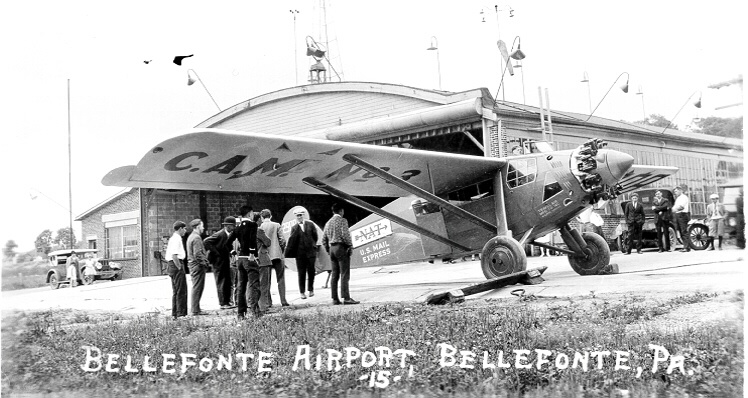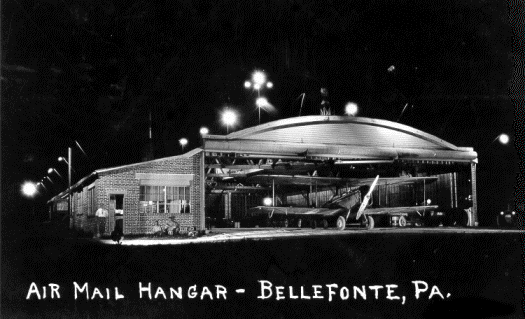In the early years of U.S. transcontinental mail, Bellefonte airfields played an important role as a major refueling stop between New York and Chicago.
In 1918, the U.S. Post Office Department (POD), the predecessor to the U.S. Postal Service, began testing airmail in the United States. On September 5, 1918, pilots Max Miller and Edward Gardner were sent to scout an airmail route from Chicago to New York.
The distance between the two cities was 821 miles and the shortest distance was a straight line that ran from New York, through Pennsylvania, across Ohio and Indiana to Chicago. Coming from Cleveland (a re-fueling spot for pilots flying from Chicago) or New York, Central Pennsylvania was the area where fuel tanks would be running low.

Bellefonte’s location was considered ideal. At 747 feet above sea level, it was drier than other nearby towns such as Lock Haven, which frequently flooded. On October 11, 1918, the POD announced that regular airmail service between New York and Chicago would begin the next month, and Bellefonte would be the only scheduled stop in Pennsylvania.
The Thomas Beaver farm, now the site of Bellefonte High School on East Bishop Street, was selected as the site of the airmail field. A hangar was erected to house three planes. Some airmail pilots were assigned to Bellefonte as their home base.
A portion of the land, about 600 feet long and 200 feet wide, served as the field while the rest remained a working farm. When planes landed, cattle grazed in a nearby pasture. At night, the cattle grazed on the landing field, keeping the grass trimmed.
Mail was flown for the first time from the field on December 18, 1918, Pilots flew an assortment of planes, including de Havilland DH-4s and Curtiss JN-4H “Jennies.” The DH-4 had been the only American-built plane that saw combat in France during World War I. Each plane’s front seat was remodeled into a compartment that could hold up to 450 pounds of mail.
The early days of aviation were hazardous. Of the pilots who were stationed at or flew through the Bellefonte field, sixteen died in the line of duty between 1918 and 1927.
Because of the technological limitations of airplanes at the time, navigating the skies was risky. Pilots guided themselves towards airfields by “contact flying,” descending low to the ground to navigate by landmarks such as railroads, waterways, topography, and buildings.
Listen to “Dead Centre” podcast about airmail pilots
Bellefonte’s geography was also a problem. The mountain ridges of Central Pennsylvania range from 440 to 2775 feet and weather conditions are often unpredictable. It was not uncommon for pilots to encounter thick low-lying fog and thermal updrafts. When pilots lost their way in the fog, they would circle until they reoriented themselves.
In the summer of 1919, a marker was placed in the mountains near Bellefonte to direct pilots to the location of the field. The marker, a two-hundred-foot-long white cross, was installed on Point McCoy, one of the highest points in the Bald Eagle Mountain range. In addition, large letters spelling “Bellefonte” were painted on the roof of the Brockerhoff House, accompanied by an arrow to point to the airfield and the number “3” to indicate the distance in miles.
In 1919, during two weeks of rain and fog on the East Coast, fifteen crashes of airmail planes were reported, damaging over a dozen planes and killing one pilot. Pilots protested the Post Office Department’s “neither rain nor snow” policy requiring them to fly the mail regardless of weather. When the POD stood firm, pilots refused to fly, beginning a strike on July 25. Pilots met with Assistant Postmaster General Otto Praeger, who refused to change the policy but did agree to allow pilots to appeal to field managers when they felt unsafe.
On November 15, 1919, the hangar at Beaver Field was destroyed in a fire thought to have been started by a stovepipe. The fire resulted in $200,000 in damages, destroying five planes, two motorcycles, and a truck. Steel strikes delayed the completion of a new hangar until 1920.

During the 1920s, the POD searched for faster and more efficient ways to deliver transcontinental mail, and airplane technology improved rapidly. Soon, all-night mail flights from New York to San Francisco became possible. Bellefonte remained a main stop on transcontinental mail routes, and a lighting system installed on the runway in 1923 allowed planes to land night and day.
In 1925, Congress passed the Kelly Bill, which aimed to “encourage commercial aviation and authorize the Postmaster General to contract for air mail service.” This opened the future of the Bellefonte field to private companies. The successful bidder of the Chicago-to-New York route was a company named National Air Transport Inc.
A new commercial airfield was completed that year outside Pleasant Gap near the current limestone plant on State Route 64. It was equipped with a larger hangar, field lights, and a beacon system. The beacons eliminated the need for contact flying and allowed for more efficient mail delivery.
However, in just a few years, airplane technology advanced to a point where planes no longer needed to refuel during transcontinental flights. By 1928, the Bellefonte field had become an intermediate landing zone for coast-to-coast mail routes.
Today, hints of the airfield’s history remain in Bellefonte. A state historical marker is at the site of the airfield, the present-day Bellefonte Area High School on East Bishop Street. A memorial to pilots who died in the line of service is at the American Philatelic Center.
Nick Malizia
Sources:
Wunderly, Kathleen. Bellefonte and the Early Air Mail, 1918-1927. Bellefonte, Pa.: American Philatelic Society, 2007.
“Air Mail Service Started This Week,” Democratic Watchman, December 19, 1918.
Fred D Smith Collection of Historic Photos and Postcards of Bellefonte The Bellefonte Airfield, Bellefonte Historical and Cultural Association http://www.bellefontearts.org/Smith_pages/Smith_airfield.htm (Accessed March 4, 2022)
First Published: April 3, 2022
Last Modified: May 19, 2022
